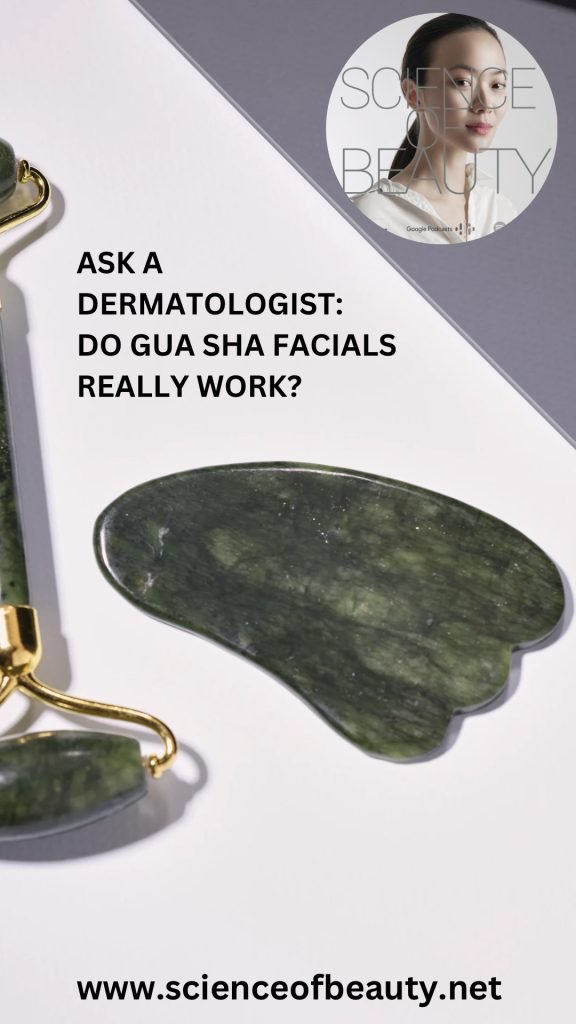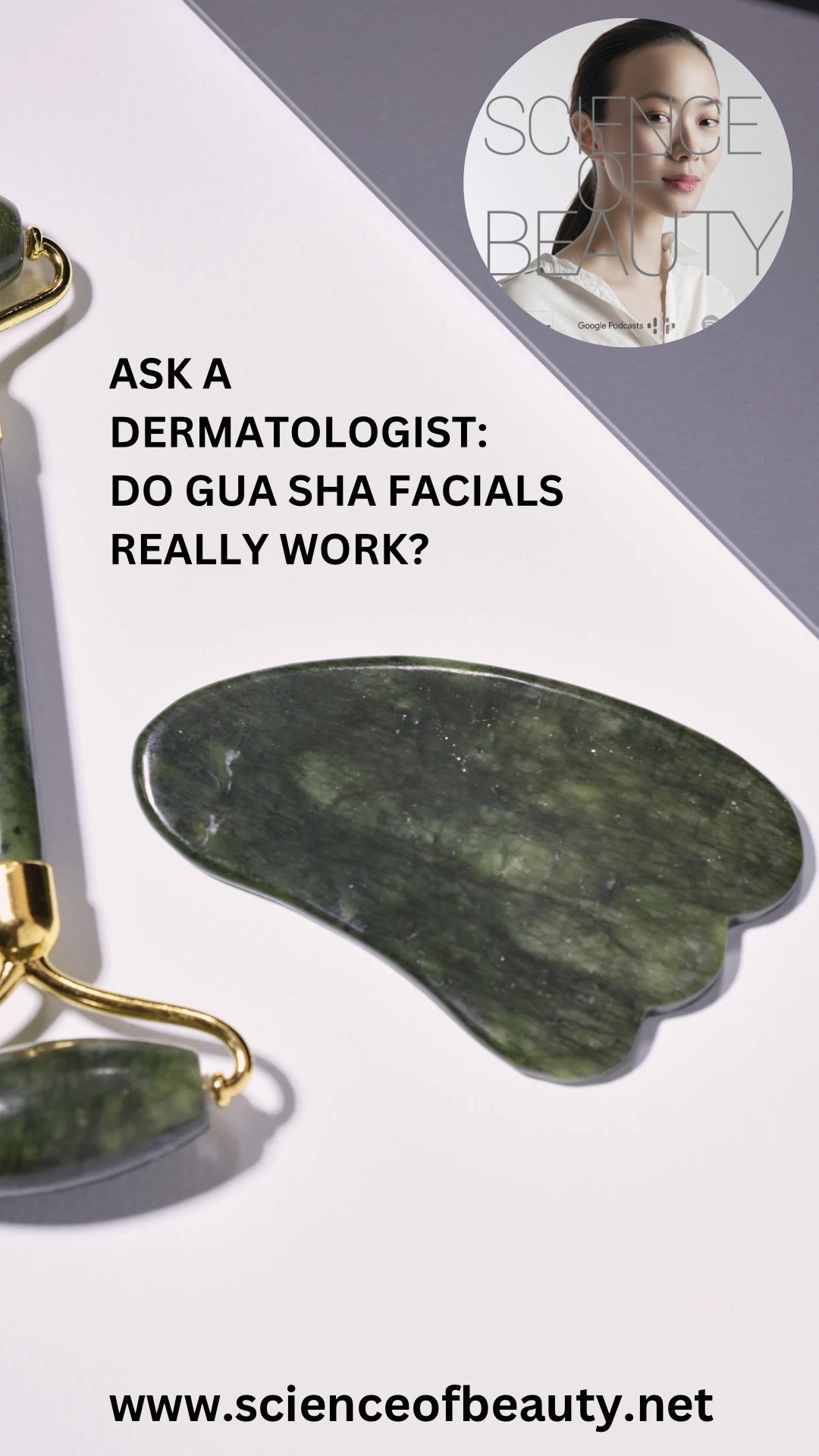Podcast: Play in new window | Download
Subscribe: Apple Podcasts | Spotify | RSS

Ep 19: The Science Behind Gua Sha – Does it Really Work?
Chelsea: Hi guys, welcome to this week’s Dermatology Flash Briefing. We are going to be starting a series on the science behind facial devices and beauty technology. Today, we’re going to be talking about the first in our series, guasha. We’ve all heard of the jade roller, but what is a Gua sha facial, and what are its benefits?
What is Gua sha?
Traditionally, Gua sha is the practice of using a tool to apply pressure and scrape the skin to relieve pain and tension, increasing blood circulation to the area. It has been popular for pain relief in the context of Eastern medicine practitioners, but we’ve also seen guasha entering the world of beauty, over the last couple of years. In the beauty world, a gua sha facial involves the use of a boomerang-shaped or curved tool usually made of jade stone or rose quartz. These are said to reduce puffiness, boost circulation, release muscle tension, and increase absorption of cosmeceuticals. Before we go into the science of whether or not this beauty tool really works, let’s find out a little bit more of where this technique came from.
The History of Gua sha
Gua sha is a therapeutic traditional East Asian healing technique. The technique is split into two parts: ‘Gua’ for scraping, ‘sha’ for redness. Other name for Gua sha include coining, scraping or spooning. Dating back to ancient China, Guasha was first referred to in a classical Chinese medicine text called Shang Han Lun dating back to 220 CCE. According to traditional chinese medicine, qi is energy that flows through the body. The Ancient Chinese believed that a person’s qi must be flowing and balanced. In order to be in good overall health and wellbeing. Practitioners of gua sha back in the day believed that inactive qi was the root of inflammation and lead to chronic pain. Hence, rubbing or scraping the skin’s surface to obtain ‘sha’ was thought to help qi flow again. This helps to reduce inflammation and promote healing.
Gua sha facial benefits
Some of the product claims of guasha tools for skincare includes its use as part of a moisturizing skincare routine. It purportedly increases skincare absorption and correspondingly the skincare benefits of active ingredients. These guasha tools also claim to stimulate skin cell renewal and improve lymphatic drainage by increasing blood flow.
Dr Teo is now going to breakdown the evidence behind these claims, if any, and share her thoughts on it as a dermatologist.
Are there any studies we know of that discuss the effects of Gua Sha on the skin?
Dr. TWL: There has been a study on the effects of Gua sha and treatment on the microcirculation of surface tissue. This was published in the Journal Explorer in 2007 by Nielsen et al.
Essentially, laser doppler images made measurements of skin circulation, specifically microcirculation before and after guasha treatment. This was conducted in Germany at the Department of Nephrology – which is dedicated to the studies of the kidney- in just 11 subjects. The results were that gua sha increased the microcirculation perfusion units by 4x at this specific treated area for the first 7 and 1/2 mins. There was a statistically significant increase in circulation after treatment for an entire 25 minutes of the study period. There was also reduction in myalgia – a sense of muscle pain, aches and soreness. This apparently applied to areas outside of guasha- treated areas as well.
Gua Sha for pain relief
Interestingly the pain relief actually continued a while after treatment and there were no adverse reactions. The conclusion of the study is that guasha increases microcirculation in the treatment area. In addition, the authors stated that this increase in circulation can play a role in the decrease in muscle pain. Specifically, they stated that the decrease in this myalgia is not only due to increase in the microcirculation at treated areas, but also other areas, far away. There was an unidentified pain-relieving biomechanism that researchers associate with guasha treatment.
This study was performed in the context of guasha for pain relief – its traditional indication. Nonetheless, we can also apply the findings to the field of skincare and dermatology because this study was performed on surface tissues. Gua sha works via the superficial tissue. As we know, guasha does result in skin surface changes of the skin. In dermatological terms, this is petechiae ecchymosis – the result of bruising on the skin because of application of mechanical forces.
Chelsea: That sounds quite painful. I’ve certainly seen people who have done cupping – the marks are quite horrific.
Does guasha leave bruises? How can facial guasha benefit skin?
Dr. TWL: As guasha does improve microcirculation, one can definitely expect that there will be an improvement in the transport of the active ingredients in his absorption via the skin when guasha is used as a tool for facial massage. However, depending on the amount of force, there can be bruising. These pinpoint breakages in your blood vessels is certainly undesirable. Besides, this can lead to facial hyperpigmentation in some individuals who are predisposed to pigmentation. Blood contains hemosiderin, which can cause brownish black deposits on skin. The mechanical trauma can also cause a form of post-inflammation hyperpigmentation.
If the goal is simply to increase local microcirculation, there are other better alternatives. Facial massage with other types of massage tools such as the Jade roller can result in increased microcirculation as well. However what I am curious about is the currently unknown mechanism of action that leads to improvement of myalgia in areas not treated directly by guasha. In science, it’s really important to keep an open mind. In my opinion, further research is definitely warranted to see if these unknown mechanisms may benefit facial skin. As well as in terms of the use of a Gua sha facial as an anti-ageing tool.
Chelsea: There certainly needs to be more studies which directly relate the effects of the Guasha technique on the skin changes. Nonetheless, there is definitely a possibility that this increase in microcirculation does bring about chemical mediators involved in wound healing. What I do know is that one of the key factors determining wound healing, after surgery is massage. Massage for early scars helps to improve the aesthetic appearance of the wound healing process.
Can you tell us more about how massage benefits the skin?
Dr. TWL: For facial guasha, it certainly seems to be increasing in popularity. The benefits of guasha, though, physiologically, currently remains unknown. The cutaneous or skin changes that occur with Guasha is well known to cause bruising and petechiae which is pinpoint bleeding under the skin. When you translate the concept to applying on the face, it’s akin to facial massage. However, you should be applying less pressure than if you were to do it on the body in traditional guasha. The data that we have now seems to suggest that physiological changes which occur primarily related to improved micro circulation. In theory this would mean that it can have the same function as a jade roller or any other massage tool. Helping to increase absorption of what is applied topically to the skin.
Chelsea: So we’ve come to the end of our podcast episode on facial guasha, the first in a series of beauty tools and devices. What are your thoughts on facial guasha? Let us know in the comments section below. Thank you for joining us, and till the next episode!


